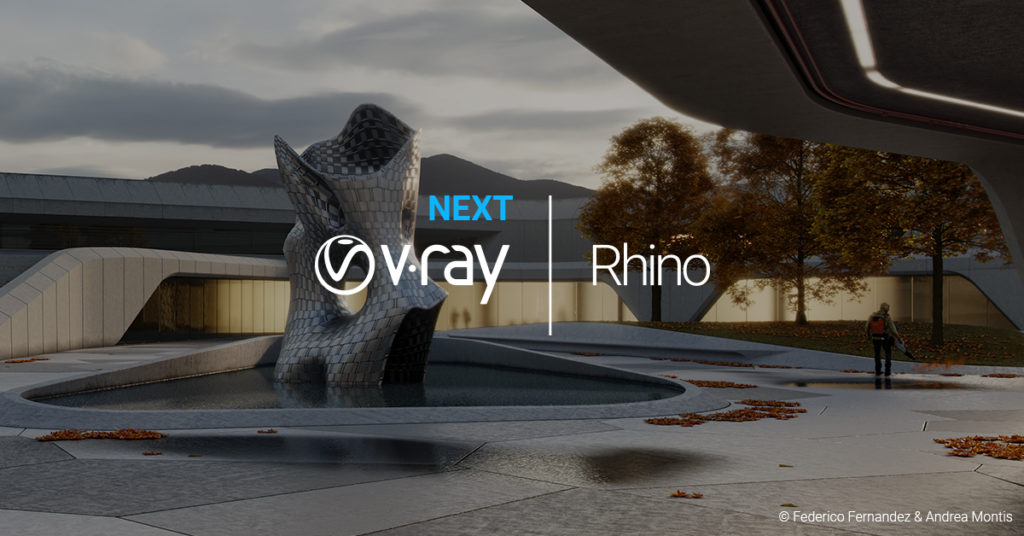V-Ray Next for Rhino, update 2.1 has been released
By Sofia Jaramillo | Visualization
V-Ray Next for Rhino is a highly accurate renderer for McNeel Rhinoceros, enabling designers to predict and present their designs with the highest level of realism and reduce the need for physical prototypes. V-Ray greatly increases Rhino’s ability to handle large scenes and can be used directly with Grasshopper.

Chaos Group just updated V-Ray Next for Rhino with a number of bug fixes and enhanced features to improve the rendering experience, including:
Workflow Improvements
- The quality slider presets are updated. The quality of the rendered image is now consistent between all the engines (CPU, CUDA and RTX) and sampler types (Progressive and Bucket).
- The quality slider presets count is increased to six. The new preset labels are ‘Low’, ‘Low+’, ‘Medium’, ‘Medium+’, ‘High’ and ‘High+’. All provide better quality than their older counterparts.
- The Maximum Subdivisions Image Sampler parameter is now visible at all times (for GPU and also in progressive rendering mode). The value used for GPU rendering is always double the CPU one to ensure consistent quality.
- The Embree related optimization parameters are automatically hidden when the GPU engine is selected. They have no effect in this case.
- The Aperture (F-Number) slider limit is removed. Values from 56 up to 985 will result in Defocus slider values between 0.1 and 0.001 to be displayed.
- Introduced a confirmation window when deleting or purging assets from the Asset Editor. Using the Shift + Delete keyboard keys removes selected assets without confirmation.
- Added full support for the _RenderBlowup, _RenderWindow, _RenderInWindow and _RenderPeviewInWindow Rhino commands.
- A new vrayRenderWindow command is implemented. It exposes three modes – Region, Cropped and Cropped Blowup. The vrayRenderBlowup command is removed – use vrayRenderWindow instead.
- A Python script wrap module is implemented.
Grasshopper
- The quality slider presets of the V-Ray Renderer component are updated. The quality of the rendered image is now consistent between all the engines (CPU, CUDA, and RTX) and sampler types (Progressive and Bucket).
- A new ‘Render Animation in Rhino’ function is added to the Render in Project component. It renders each Grasshopper animation frame state together with the Rhino scene. Object animations are fully supported.
- The Material Preset component’s Color parameter can now be textured with a V-Ray Bitmap.
- An issue causing specific Grasshopper animations frame ranges to be sent incorrectly to the Rhino project is resolved.
- Polysurface objects referenced in Grasshopper and rendered via the V-Ray Geometry component no longer have faulty UV texture coordinates.
- A number of issues related to displacement rendering in Grasshopper are resolved.
- Animation rendering, exporting animated proxies or scenes is now possible with a C# / Python script component.
Other changes and bug fixes
- Randomize Material ID Colors now works as expected.
- The Multimatte Materials render element now works as expected.
- Render regions can now be specified prior to any rendering.
- A number of tooltips, as well as some Grasshopper component descriptions, are updated.
- Decreasing the V-Ray interactive viewport (VPR) size with the vrayVPRSettings command no longer causes issues.
- An issue with the appearance of Rhino materials rendered in V-Ray is resolved.
- An issue caused by proxy mesh manipulations while the vrmesh file is on a network drive is resolved.
- The precision and default range of the Camera / Effects / Vertical Lens Tilt slider are updated.
- The default range of the Camera / Effects / Vignetting slider is decreased.
Installation & Licensing
- The Chaos Group License Server is updated to version 5.4.0
If you would like to upgrade your V-Ray 3.0 for Rhino licenses to V-Ray NEXT for Rhino, please contact us at vray@microsolresources.com.
If you are not sure about upgrading your licenses, you can request a free 30-day trial, to get an overview of its new features and functionality. You can test it out with your team and find out how this new version will improve your workflow.
INDUSTRIES:







